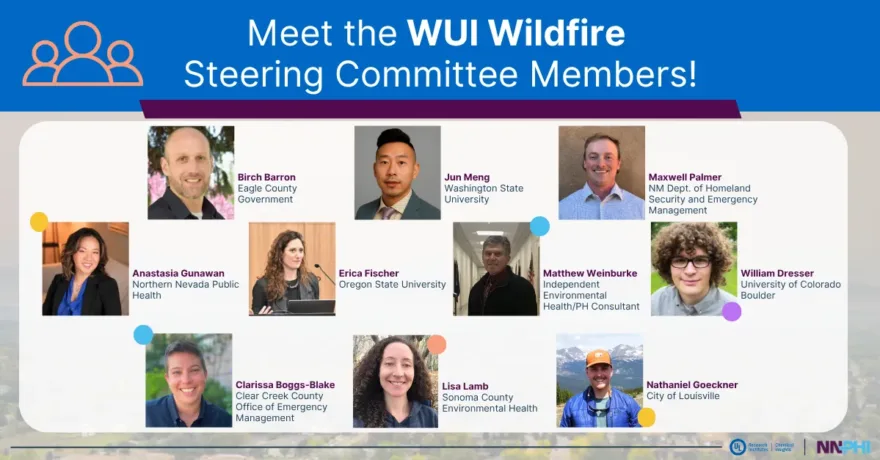From mountain towns and desert cities to coastal communities—a newly launched steering committee convened by the National Network of Public Health Institutes and UL Research Institutes’ Chemical Insights, an NNPHI member institute, brings together stakeholders living and working in homes and communities at the intersection of wildland and urban areas, where wildfire risks pose an emerging challenge in public health.
Wildfires are a natural part of many ecosystems. However, these events are becoming more frequent, lasting longer, and leaving lasting public health impacts such as poor air quality, settled dust and smoke exposure. While attention often centers on rural areas, communities near urban settings are increasingly at risk. The wildland urban interface (WUI)—defined as the “line, area, or zone where structures and other human development meet or intermix with undeveloped wildland or vegetation fuel”—captures these vulnerable spaces where nature and neighborhoods collide.
As witnessed during the Lahaina, Hawaii and Los Angeles fires, communities living in the WUI face elevated risks due to factors like population density, challenging topography, and vegetation conditions worsened by drought or extreme weather.
To address these challenges, NNPHI has brought together a diverse group of experts in public health, data science, emergency preparedness, and exposure science. Together, the steering committee will provide guidance, recommend modifications to communication resources, and inform community-based practices around wildfire preparedness and health communication in the WUI. These findings will be shared with the greater public health field and become assets to state and local jurisdictions advocating for more resources and support in the WUI space.
Building Collaboration
On November 6, 2025, NNPHI hosted the committee’s inaugural meeting, beginning meaningful discussions about how data and communication tools can better support public health professionals working in wildfire-prone regions.
The group shared insights on:
- Useful data sources and indicators for wildfire mapping tools
- The accessibility and equity of existing WUI maps
- Key gaps that should be addressed—especially around public health implications and community preparedness
Voices from the Field
Committee members emphasized the importance of connecting research, lived experiences, and local expertise to make public health preparedness more effective.
“The United States is a vast country, and it can be challenging to stay informed,” said Nathaniel Goeckner, MEnv, natural resource supervisor with the City of Louisville. “Collaborating helps break down barriers and allows for the flow of strategies and other ideas to be incorporated into the wildfire mitigation space.”
“In WUI communities, wildfire, smoke, evacuation, and health impacts intersect,” said Anastasia Gunawan, MPH, statistician with the Population Health Division at Northern Nevada Public Health. “Data turns good intentions into measurable safety by quantifying risk reductions—showing for whom, and at what cost. WUI tools translate data into decisions, ensuring policy reduces risk where it’s highest, and protection reaches those who need it most. The ultimate goal is to save lives and uphold equity, with measurable proof.”
“This steering committee is important to me because I serve as an advocate and provide my expertise on climate change and environmental health issues,” said Matthew Weinburke, DrPH, MPH, MCHESR, REHS, a consultant who has more than 20 years of experience in public health education, training, and environmental health. “I also live in a wildfire urban interface county, and it’s important to have individuals who live and respond to wildfire/wildland fire to be in the committee.”
“Steering committees help ensure we’re framing the right questions in the right way,” said Max Palmer, lead local preparedness coordinator at the New Mexico Department of Homeland Security and Emergency Management. “Coordination is the scarcest resource in the world. Leveraging real-world experience from diverse practitioners helps connect problems to resources—and resources to solutions.”
Palmer also highlighted how emergency management and public health overlap:
“When disasters disrupt essential services, emergency managers must find ways to restore the lifelines that support communities. I hope the products from this committee will guide planning for those tasked with restoring these lifelines in wildfire-prone areas.”
Partnering for Safer Communities
This steering committee is possible thanks to NNPHI’s partnership and support from the UL Research Institutes’ Chemical Insights team, who bring decades of expertise in chemical safety and exposure science to this effort.
“Our work focuses on understanding the chemical and material processes we encounter in daily life—particularly when they are altered by combustion,” said Mark Wilson, MSPH, PhD, CIH, research director at Chemical Insights’ Center for Exposure Science. “By studying the chemical aftermath of fires, we can help communities better understand exposure risks and build safer environments.”
Looking Ahead
Diana Hamer, PhD, director of NNPHI’s Environmental Health and Emergency Preparedness team, expressed enthusiasm for this cross-sector collaboration.
“Bridging the gap between public health and wildfire preparedness is essential,” said Hamer. “This steering committee brings together expertise, lived experience, and data-driven insight to help communities better prepare, respond, and recover.”
Over the next several months, the committee will develop recommendations, share insights, and co-create tools that help public health and emergency management professionals communicate effectively about wildfire risk and resilience in WUI communities.

